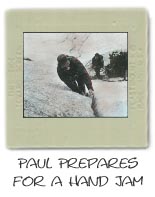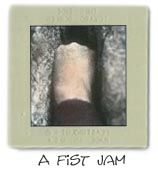|

|
At first glance, the human body seems to be built wrong: the levers are backwards. Consider the elbow. When you hold a can of soda in your hand with your elbow bent at a right angle, the weight of the can pulls the lower arm down, pivoting it about the elbow joint. The bicep muscle pulls up on the lower arm, fighting gravity and holding the arm in place But, as anyone who has used a lever knows, the farther the force is from the pivot, the greater the twisting force, or torque, it exerts. If you push on a door at the knob, it pivots easily on its hinges. But try pushing a door open with your hand placed only a few inches from the hinge The closer your hand is to the hinge, the more difficult it is to open the door. Similarly, the can is five times further from the elbow than the bicep attachment. To hold up a one-pound can, the bicep muscle must pull up with five pounds of force. |
| The whole human body is designed this way. Almost every muscle, including those of the hand, works at a mechanical disadvantage. The muscle must exert more force than the weight opposing it. Why? The real problem is that muscles cannot move very far. As it is, the muscle must exert five pounds of force to lift a one-pound can. But if the can is lifted one foot, the muscle only needs to contract one-fifth of a foot, a little over two inches. If the body were designed with a mechanical advantage of five, then the muscle would only have to pull with one-fifth of a pound of force, but it would have to contract five feet, and our elbows would drag across the ground. |

|
| After all these musings, I still hadn't felt another hold. I could see a narrow slot a few feet above me, out of reach at the moment. If I could just get my fingers into it, I thought, I would be over the crux. I put my foot up and pulled again. The muscles in my forearms pulled with a half ton of force and lifted me slowly up, working at a disadvantage against gravity. My other hand reached up and jammed into the enticing hold. It wasn't a hole at all, just a rounded slimy place I was in trouble I had foolishly assumed that it would be a good hold and I was wrong. Since I had moved up, I couldn't pull my body into the rock as strongly as before and my foot began to slip. My free hand rapidly searched for invisible holds and, luckily, found one: a single rough crystal. I smashed my index finger down onto that crystal and piled the other fingers and thumb of that hand on top of it. Then I pulled up, easing the load on my foot. |
|
My second foot felt out to the right, looking for holds. No luck. Trusting the finger pile, I let go of the wet hold and reached up further. At last, my fingers slipped into a crack and I began to feel better. A quick pull and I was above the crux. I found good footholds, placed some protection, and let out a yell. In a few more feet, I arrived at a ledge big enough to sit on. I tied myself to the mountain and called "Off belay,' letting Mike know that my life was my own responsibility again. I wrapped the rope around my waist, grabbed the rope in a power grip, and called, "On belay" Mike followed me up the climb. He flowed up in great style, but I was secretly pleased when he slowed down a little at the crux. He joined me at the belay ledge and we shook hands. He said, "Nice lead, PD,' which translates into, "I noticed the crux and I'm glad it was your lead" I was ecstatic. After all, we had come one-tenth of the way; we only had nine hundred feet to go! It was Mike's turn to lead. The crack was bigger now, big enough to swallow an entire hand. Mike didn't need to use any of Napier's grips. Instead, he jammed his entire hand into the crack, using it as a wedge, to hold his weight. Dr. Napier would probably have cringed at what Mike was doing to his hand, but the hand jam held Mike firmly in place, attached to the mountain. |

|